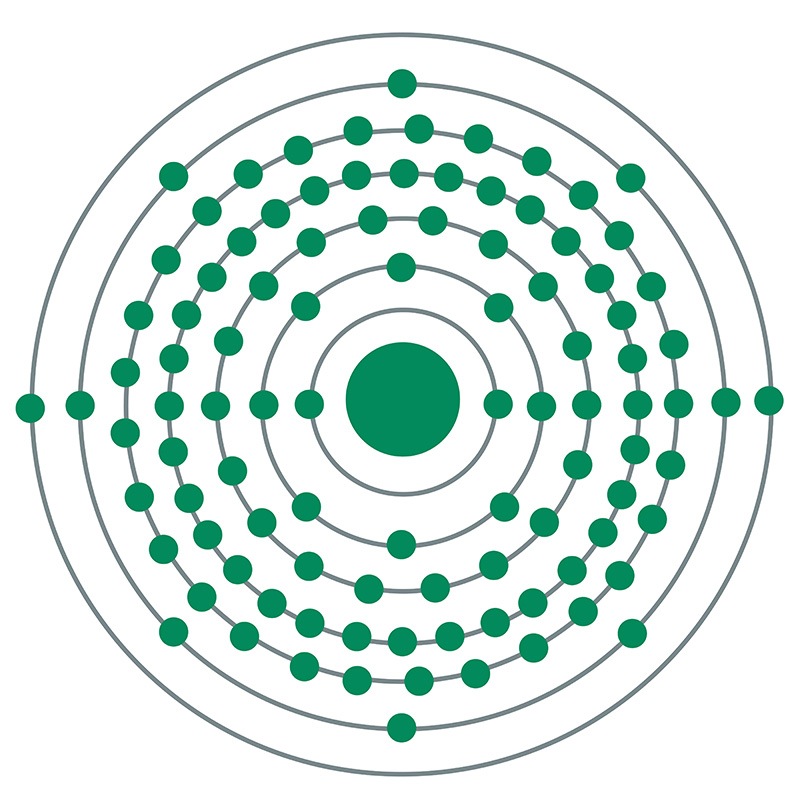Math Is Fun Forum
You are not logged in.
- Topics: Active | Unanswered
Pages: 1
#1 2025-10-06 20:42:49
- Jai Ganesh
- Administrator

- Registered: 2005-06-28
- Posts: 52,018
Einsteinium
Einsteinium
Gist
Einsteinium (Es) is a highly radioactive, synthetic element with atomic number 99, named after Albert Einstein. It belongs to the actinide series on the periodic table and was discovered in 1952 within the debris of the "Ivy Mike" hydrogen bomb test. Due to its extremely short half-life and high radioactivity, einsteinium is produced in minuscule amounts and is almost exclusively used in fundamental scientific research, particularly for the synthesis of heavier elements.
Einsteinium has no commercial uses due to its scarcity and high radioactivity, but it is used in scientific research for synthesizing other heavy elements like mendelevium, studying the chemistry of superheavy elements and actinides, and investigating nuclear processes. It serves as a crucial waypoint and research tool, providing insights into element properties at the far end of the periodic table and informing studies on radiation damage and potential medical applications.
Summary
Einsteinium is a synthetic chemical element; it has symbol Es and atomic number 99 and is a member of the actinide series and the seventh transuranium element.
Einsteinium was discovered as a component of the debris of the first hydrogen bomb explosion in 1952. Its most common isotope, einsteinium-253 (253Es; half-life 20.47 days), is produced artificially from decay of californium-253 in a few dedicated high-power nuclear reactors with a total yield on the order of one milligram per year. The reactor synthesis is followed by a complex process of separating einsteinium-253 from other actinides and products of their decay. Other isotopes are synthesized in various laboratories, but in much smaller amounts, by bombarding heavy actinide elements with light ions. Due to the small amounts of einsteinium produced and the short half-life of its most common isotope, there are no practical applications for it except basic scientific research. In particular, einsteinium was used to synthesize, for the first time, 17 atoms of the new element mendelevium in 1955.
Einsteinium is a soft, silvery, paramagnetic metal. Its chemistry is typical of the late actinides, with a preponderance of the +3 oxidation state; the +2 oxidation state is also accessible, especially in solids. The high radioactivity of 253Es produces a visible glow and rapidly damages its crystalline metal lattice, with released heat of about 1000 watts per gram. Studying its properties is difficult due to 253Es's decay to berkelium-249 and then californium-249 at a rate of about 3% per day. The longest-lived isotope of einsteinium, 252Es (half-life 471.7 days) would be more suitable for investigation of physical properties, but it has proven far more difficult to produce and is available only in minute quantities, not in bulk. Einsteinium is the element with the highest atomic number which has been observed in macroscopic quantities in its pure form as einsteinium-253.
Like all synthetic transuranium elements, isotopes of einsteinium are very radioactive and are considered highly dangerous to health on ingestion.
Details
Einsteinium (Es) is a synthetic chemical element of the actinoid series of the periodic table, atomic number 99. Not occurring in nature, einsteinium (as the isotope einsteinium-253) was first produced by intense neutron irradiation of uranium-238 during the detonation of nuclear weapons. This isotope was identified in December 1952 by Albert Ghiorso and coworkers at Berkeley, California, in debris taken from the first thermonuclear (hydrogen bomb) explosion, “Mike,” in the South Pacific (November 1952). The element was named after the German-born physicist Albert Einstein.
The material was first collected on filter paper by drone airplanes flying through the radioactive explosion clouds; later, einsteinium and element 100 (fermium) were positively identified in coral gathered from Enewetak Atoll. In each case the identification required chemical separation and observations of characteristic nuclear reactions in laboratories.
All einsteinium isotopes are radioactive. Mixtures of the isotopes einsteinium-253 (20.5-day half-life), einsteinium-254 (276-day half-life), and einsteinium-255 (39.8-day half-life) can be produced by intensive slow-neutron irradiation of elements of lower atomic number, such as plutonium.
Despite the short half-lives and scarcity of einsteinium isotopes, einsteinium metal has been prepared in milligram ({10}^{-3} gram) amounts. Unlike most of the lanthanoid metals and the actinoids americium through californium, einsteinium metal has a face-centred cubic structure resembling the metallic lanthanoids europium and ytterbium. Tracer studies indicate that the +3 oxidation state exists in solid compounds and in aqueous solution as the Es3+ ion; there is also some evidence for a +2 state in some nonaqueous solutions, solid solutions, and gaseous species. Einsteinium has chemical properties very similar to those of the other actinoid elements in the tripositive state. Einsteinium-255 and einsteinium-256 eject electrons to form isotopes of fermium (atomic number 100), and mendelevium (atomic number 101) isotopes have been produced by bombarding einsteinium-253 “targets” with alpha particles in cyclotrons or linear accelerators.
Element Properties
atomic number : 99
stablest isotope : 252
oxidation states : +2, +3.
Additional Information:
Appearance
A radioactive metal, only a few milligrams of which are made each year.
Uses
Einsteinium has no uses outside research.
Biological role
Einsteinium has no known biological role. It is toxic due to its radioactivity.
Natural abundance
Einsteinium can be obtained in milligram quantities from the neutron bombardment of plutonium in a nuclear reactor.

It appears to me that if one wants to make progress in mathematics, one should study the masters and not the pupils. - Niels Henrik Abel.
Nothing is better than reading and gaining more and more knowledge - Stephen William Hawking.
Online
Pages: 1